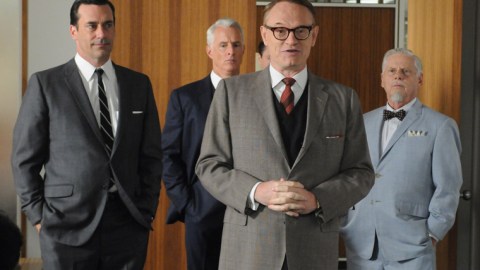Truth and Fiction in Mad Men

Matt Steinglass, my colleague at The Economist‘s Democracy in America blog, notes that a scene in the season premiere of Mad Men widely panned by critics is based closely on historical fact. He then asks:
Are the critics right to say that in judging whether this scene in “Mad Men” works dramatically, it’s immaterial whether or not it actually happened?
No. They’re wrong. Look: imagine you’re the writer on this episode, and you’re looking for a way to relate the racial tensions of 1966 to your show about Madison Avenue advertising jocks. You come across a front-page article from 1966 describing Madison Avenue advertising jocks dumping water on the heads of black protestors. The scene is tight, clipped, dramatic, easily adapted for TV. In the face of this article, what other scene are you instead going to write, which you believe more fully expresses the truth of the relationship between Madison Avenue advertising jocks and black protestors in 1966? What other dialogue are you going to put in, that sounds more convincing than what the people at the time actually said? What do you know about this situation that John Kifner did not know on May 28, 1966, when he stood there and watched it?
Preposterous, I say!
First of all, the scenes in question really were terrible and left me and apparently lots of other people cringing, especially the line, “And the call us savages!” So what if it was lifted straight from a newspaper? Matt defends Matthew Weiner’s lazy dependence on the crutch of historical fact by challenging critics to describe an alternative scene that would better make the same socio-historical point. Well, it’s not generally incumbent on critics to improve bad writing before noting that it’s bad. Anyone can see that these scenes were stilted, awkward, and smacked of a Very Special Episode. That Weiner pulled the scene out a newspaper doesn’t change that.
Mad Men is a work of historical fiction. The implicit contract of the show, especially as Weiner has developed it, promises a certain level of fidelity to the facts of history. But, look: it is a rudimentary principle of non-fiction writing that the fact something actually happened is not a good reason to put it in. Budding memoirists and essayists constantly attempt to justify boneheaded aesthetic choices by protesting that “it really happened!” If we begin with the understanding that, to a first approximation, almost nothing that actually happened will make it into a completely true story, it’s easy to appreciate that leaving out just a few more things that really happened won’t hurt it. Most facts are simply irrelevant to the thrust of a non-fiction story, and are thus best omitted. And many things that actually happen are, frankly, unbelievable, and their inclusion can ruin an otherwise excellent piece. If this is true of non-fiction, it’s doubly true of fiction.
Weiner would have been wiser to fire up his imagination and find a way more gracefully to convey the desired socio-historical gist. If there’s really no superior alternative to his newspaper cut-and-paste job, then Weiner would have done better to have taken the story in an altogether different direction. That there’s no way of telling this particular story without including a couple awful scenes does not strike me as an argument against the awfulness of those scenes. It strikes me an argument for telling a different story.
Matt goes on to argue:
“Mad Men” derives a great deal of its power from the way it sets its audience’s own particular norms and values in stark relief by presenting us with fully realised characters whose reactions and judgments are genuinely off from ours, in ways that are bound up with the period in which those characters lived. That is not purely an aesthetic enterprise; it is also an ethical one (not that aesthetics and ethics are entirely separate). If you draw your power from the gap the mores of your audiences and their time and those of your characters and theirs, you owe it to your audience and to the art itself to be true to what you discover about that history.
I agree in a broad sense that Weiner owes it to both his audience and his art to be true to what he discovers about the history of the era he’s chosen to depict. But that doesn’t mean Mad Men would be a better show if it featured Jon Hamm reading relevant newspaper articles over Ken Burns-style pans of photographs of the real world of the 1960s ad biz. Mad Men draws its power mainly from telling good stories well. If it doesn’t do this, it can’t make us care about the exotic near past. The way this works, if it does, is that Weiner and Co. artfully make tons of shit up that is broadly consistent with history. Even if we allow that part of the value of the show is didactic, story is the medium through which it achieves its didactic aims. The ham-handed use of newspaper clippings actively undermines these aims by jolting viewers out of the dreamworld of the narrative.
Photo Credit: Michael Yarish/AMC





